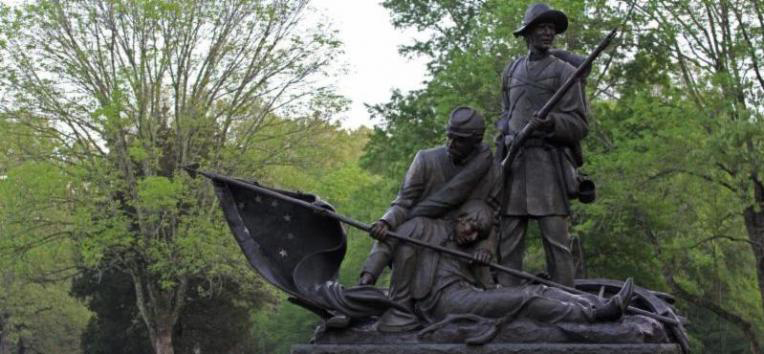
Shiloh Battlefield Monument
September 21, 2017 - Confederate monuments have taken center stage, abhorred by those who see tributes to slaveholders and defended by others as a part of U.S. heritage.
Both are right, and shamefully so, noted Brandon Wolfe-Hunnicutt, assistant professor of history at California State University, Stanislaus, in a talk given on campus Sept. 7.
The Confederacy’s legacy of tall statues and civic names came years after the end of the Civil War, Wolfe-Hunnicutt said. “They were creating a built norm, where these values become part of the built environment, something that had just always been there,” he told a packed room of University students and staff.
The number of monuments grows with each era of civil strife around race, making the patinated metal and engraved stone inseparable from the flesh and blood they immortalize. “Certain times and values are being enshrined and others aren’t,” he said.
The white supremacists recently seen carrying torches in Charlottesville, Virginia, shocked many, but their chants echoed ideas as old as America, he said. In the 1770s, fears that England would outlaw slavery became a part of the rallying to revolution in the colonies.
As the colonies grew, the practice was outlawed in the industrial north and expanding territories west. In the south, slavery supported large plantations, but also depressed wages for the vast majority of whites who owned no slaves, he pointed out. To broaden Confederate support beyond the wealthy few who stood to gain, secessionists made a case for state sovereignty and preserving whites’ superior station, laid out clearly in their Declaration of Causes for secession.
The Texas declaration of 1861 includes this: “We hold as undeniable truths that the governments of the various States, and of the Confederacy itself, were established exclusively by the white race, for themselves and their posterity; that the African race had no agency in their establishment; that they were rightfully held and regarded as an inferior and dependent race, and in that condition only could their existence in this country be rendered beneficial or tolerable.”
“They weren’t shy about it,” Wolfe-Hunnicutt said. “That’s what they fought for. That’s what they went to war for.” The rich did not actually go to war, he added, since owners of 20 slaves or more were excused from the Confederate draft.
But Southern forces faced an adversary with deeper pockets, more manpower and the help of those fighting for their children’s freedom as much as their own. “The union’s best spy was Harriet Tubman,” the historian said, noting slaves were privy to critical details like southern arms caches and troop movements. It is his belief, Wolfe-Hunnicutt said, that the fervor of black union soldiers moved President Abraham Lincoln to shift his objective from simply containing slavery to abolishing it.
Confederate monuments did not rise during or after the war, he said. The burnishing of Southern memory came into fashion as part of a backlash to Reconstruction. The Shiloh Battlefield monument to fallen Tennessee soldiers pictured here was dedicated in 2005.
From the 1890s to 1920s the Ku Klux Klan flourished, universities taught the false science of eugenics and courts refuted the promised rights of post war Constitutional amendments. Klan sympathizers filled statehouses across the South, “Birth of a Nation” (a paean to white supremacy) was the first film to be shown at the White House, and in 1925 white-robed Klansmen marched 50,000 strong through the streets of Washington D.C.
Tributes to the Confederacy again gained ground after passage of the Civil Rights Act and the Voting Rights Act of 1964 and 1965 — both created to enforce what was already law, Wolfe-Hunnicutt commented.
After the election of the nation’s first black president, race again became a lightning rod. Police enforcement, political rhetoric and social commentary deepened divides. The Supreme Court scaled back the Voting Rights Act. Marchers picked up torches, proclaiming white supremacy.
Much that was old seems new again.
This time, however, the monuments are losing the battle. “Fewer people are willing to defend statues. … But the statues are the easy part,” Wolfe-Hunnicutt said in conclusion. Reversing centuries of racial inequity in healthcare, education, legal rights and earnings — “that’s what’s hard.”
Brandon Wolfe-Hunnicutt teaches courses in U.S. and Middle Eastern history and is completing a book on American foreign policy, oil interests and the 1968 coup in Iraq. He holds a Ph.D. in history from Stanford University (2011) and has taught at Stanislaus State since 2014.
Source: Stanislaus State









